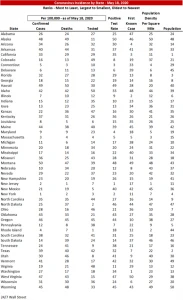Incidence of Coronavirus by State - May 2020
While the world has now reached a confirmed 5 million cases of Coronavirus, three-in-10 (31.3 percent) of those are in the U.S.-- though the 50-states make up just 4.3 percent of the world’s population. Thus far the U.S. has tallied 454.4 confirmed Coronavirus cases per 100,000 people compared to 65.8 per 100,000 average across the globe. A level of 500 per cases per 100,000 population represents a 0.5 percent occurrence. In contrast, the global infection rate of H1N1 (Swine Flu) in 2009 was 24 percent.
24/7 Wall Street released a study detailing Coronavirus by states as of May 18, 2020. Coronavirus data were reported on an incidence per 100,000 people allowing comparisons of states with different populations and densities. The distribution of these cases in the U.S., however, is not equal across the country. The first Stewart blog more than a decade ago included the TINSTAANREM axiom — There Is No Such Thing As A National Real Estate Market. That also applies to the incidence and impact of the Coronavirus. Just like real estate and the economy, locality rules.
24/7 Wall Street’s study included the following data by state:
- Confirmed Cases per 100,000
- Deaths per 100,000
- Tested per 100,000
- Positive Tests percent
- Date of First Known Case
- Population Density per Square Mile
- Total Population
The first table shows the number of Confirmed Cases per 100,000, by state, ranked from most to least. New York with almost 1,800 cases has had an infection rate that is 40 times greater than Montana, with the least at 44 cases per 100,000 people.
 <http:>
<http:>
The next table ranks Deaths per 100,000 by state. Not surprisingly, nine of the top-10 states ranked on Deaths per 100,000 were also included in the top-10 Confirmed Cases per 100,000. New Jersey Coronavirus Death Rate (highest ranked at 117.1 deaths per 100,000) is almost 100 greater than Hawaii (lowest at 1.2).
 <http:>
<http:>
Unexpected (to me) in the 10 states with the greatest death rate was the absence of the five states having the oldest median age. Age alone is not responsible for the greater loss rate.
State Median Age & Age Rank Deaths Per 100,000 Rank
Maine 44.9 1st 38th
New Hampshire 43.0 2nd 20th
Vermont 42.8 3rd 28th
West Virginia 42.7 4th 43rd
Florida 42.2 5th 27th
 <http:>
<http:>
The next two tables show Coronavirus Testing (expressed as the number tested per 100,000 population) and the Percent of Positive Tests. Rhode Island is the only state with 10 percent of the total population tested coming in at 10,913 tests per 100,000 people. Just 11.1 percent of those tested came back as positive. In comparison, Florida has tested just one-third of that number (3,182 tests per 100,000) with a 6.9 percent positive rate.
 <http:>
<http:> <http:>
<http:>
The next table is sorted by the first Confirmed Coronavirus Case Date. Although Washington had the earliest confirmed case in the U.S. just after mid-January, they rank 27th in confirmed cases per 100,000 population, California was the third state with Coronavirus but ranks 33rd in confirmed cases and Arizona was 4th by date but came in 34th in confirmed cases.
 <http:>
<http:>
Population Density Per Square Mile is shown in the next table. Seven of the 10-states with the most Confirmed Cases Per 100,000 are include in the 10 most densely populated states. Florida with the 8th most dense population, however, ranked 32nd in Confirmed Cases and Ohio (10th most densely populated) ranked 28th.
 <http:>
<http:>
The next table shows all metrics sorted alphabetically by state for ease of review.
 <http:>
<http:>
To get numbers out of the way, so-to-speak, the last table shows the relative rank of each of the metrics, each sorted from largest to smallest or oldest to newest. Comparing ranks gives a method to view the big picture without the individual numbers getting in the way, akin to the statement, “Can’t see the forest for the trees.” Alabama, for example, ranks middle of the pack for all ranks except First Known Case, where it came in as the fourth to last-state to have a confirmed coronavirus case on March 13, 2020, almost two months after the first confirmed case in Washington on January 21, 2020.

To read the entire 24/7 Wall Street study click https://247wallst.com/special-report/2020/05/19/states-with-the-highest-number-of-covid-19-cases-7/2/
My one forecast is that in some high-density, high-rate of contagion markets, there will be an accelerated out-migration as people pursue perceived lower infection locales.
Ted
